2018 KIA K900 ECU
[x] Cancel search: ECUPage 7 of 544
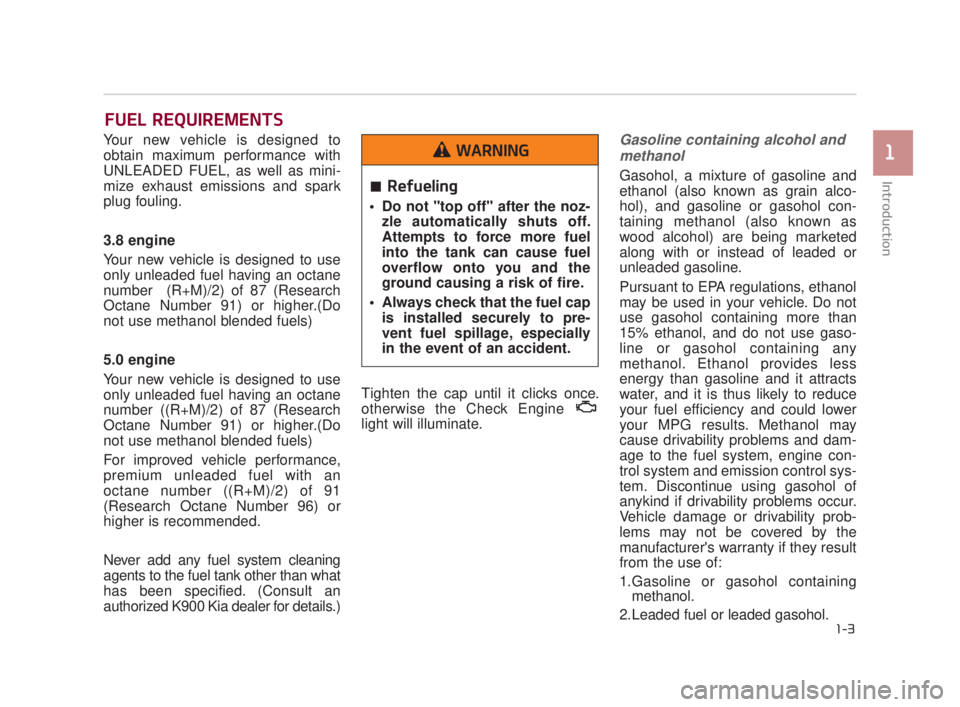
Your new vehicle is designed to
obtain maximum performance with
UNLEADED FUEL, as well as mini-
mize exhaust emissions and spark
plug fouling.
3.8 engine
Your new vehicle is designed to use
only unleaded fuel having an octane
number (R+M)/2) of 87 (Research
Octane Number 91) or higher.(Do
not use methanol blended fuels)
5.0 engine
Your new vehicle is designed to use
only unleaded fuel having an octane
number ((R+M)/2) of 87 (Research
Octane Number 91) or higher.(Do
not use methanol blended fuels)
For improved vehicle performance,
premium unleaded fuel with an
octane number ((R+M)/2) of 91
(Research Octane Number 96) or
higher is recommended.
Never add any fuel system cleaning
agents to the fuel tank other than what
has been specified. (Consult an
authorized K900 Kia dealer for details.)Tighten the cap until it clicks once.
otherwise the Check Engine
light will illuminate.Gasoline containing alcohol and
methanol
Gasohol, a mixture of gasoline and
ethanol (also known as grain alco-
hol), and gasoline or gasohol con-
taining methanol (also known as
wood alcohol) are being marketed
along with or instead of leaded or
unleaded gasoline.
Pursuant to EPA regulations, ethanol
may be used in your vehicle. Do not
use gasohol containing more than
15% ethanol, and do not use gaso-
line or gasohol containing any
methanol. Ethanol provides less
energy than gasoline and it attracts
water, and it is thus likely to reduce
your fuel efficiency and could lower
your MPG results. Methanol may
cause drivability problems and dam-
age to the fuel system, engine con-
trol system and emission control sys-
tem. Discontinue using gasohol of
anykind if drivability problems occur.
Vehicle damage or drivability prob-
lems may not be covered by the
manufacturer's warranty if they result
from the use of:
1.Gasoline or gasohol containing methanol.
2.Leaded fuel or leaded gasohol.
FUEL REQUIREMENTS
Introduction
1
1-3
Refueling
Do not "top off" after the noz- zle automatically shuts off.
Attempts to force more fuel
into the tank can cause fuel
overflow onto you and the
ground causing a risk of fire.
Always check that the fuel cap is installed securely to pre-
vent fuel spillage, especially
in the event of an accident.
WARNING
KH USA 1:2016 12/1/2016 9:43 PM Page 3
Page 23 of 544
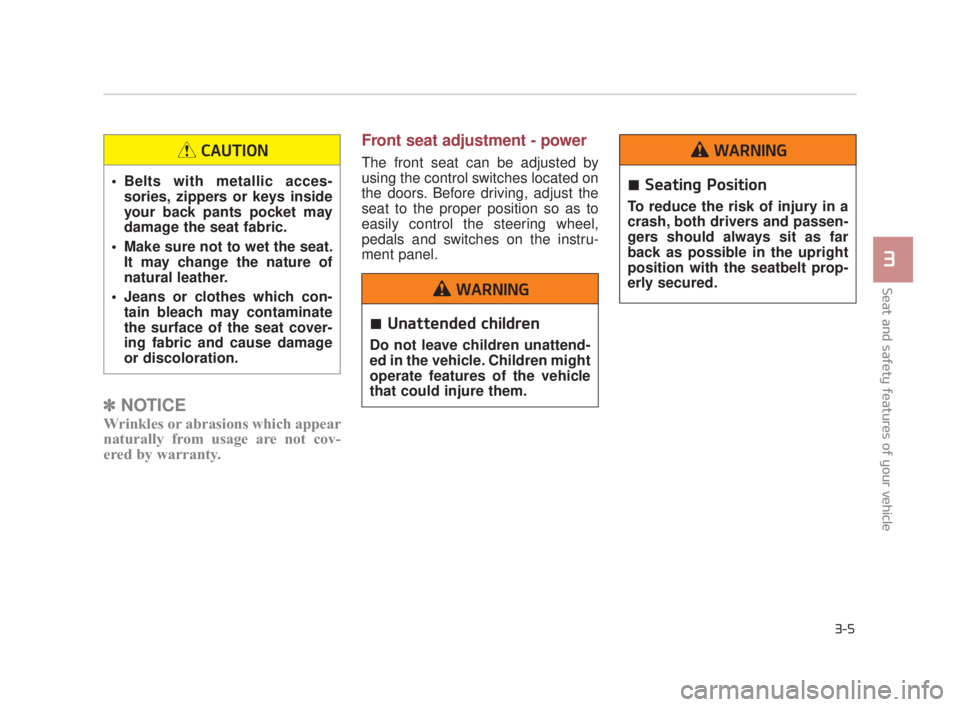
Seat and safety features of your vehicle
3
3-5
✽NOTICE
Wrinkles or abrasions which appear
naturally from usage are not cov-
ered by warranty.
Front seat adjustment - power
The front seat can be adjusted by
using the control switches located on
the doors. Before driving, adjust the
seat to the proper position so as to
easily control the steering wheel,
pedals and switches on the instru-
ment panel.
Unattended children
Do not leave children unattend-
ed in the vehicle. Children might
operate features of the vehicle
that could injure them.
WARNING
Seating Position
To reduce the risk of injury in a
crash, both drivers and passen-
gers should always sit as far
back as possible in the upright
position with the seatbelt prop-
erly secured.
WARNING
Belts with metallic acces-
sories, zippers or keys inside
your back pants pocket may
damage the seat fabric.
Make sure not to wet the seat. It may change the nature of
natural leather.
Jeans or clothes which con- tain bleach may contaminate
the surface of the seat cover-
ing fabric and cause damage
or discoloration.
CAUTION
KH USA 3:2018 4/18/2017 9:34 AM Page 5
Page 31 of 544
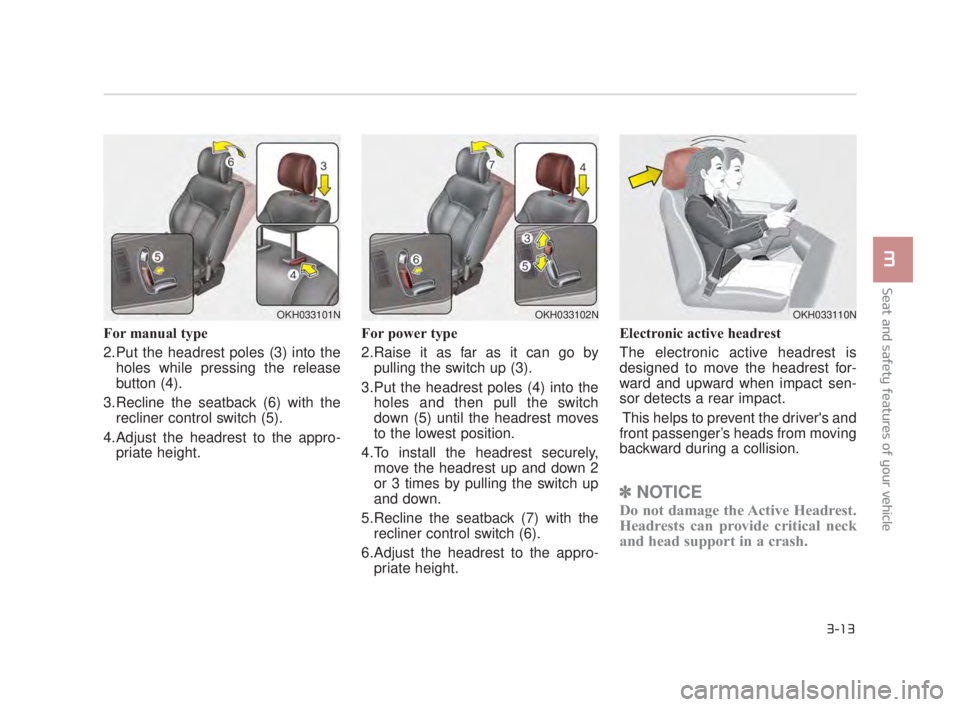
Seat and safety features of your vehicle
3
3-13
For manual type
2.Put the headrest poles (3) into theholes while pressing the release
button (4).
3.Recline the seatback (6) with the recliner control switch (5).
4.Adjust the headrest to the appro- priate height. For power type
2.Raise it as far as it can go by
pulling the switch up (3).
3.Put the headrest poles (4) into the holes and then pull the switch
down (5) until the headrest moves
to the lowest position.
4.To install the headrest securely, move the headrest up and down 2
or 3 times by pulling the switch up
and down.
5.Recline the seatback (7) with the recliner control switch (6).
6.Adjust the headrest to the appro- priate height. Electronic active headrest
The electronic active headrest is
designed to move the headrest for-
ward and upward when impact sen-
sor detects a rear impact.
This helps to prevent the driver's and
front passenger’s heads from moving
backward during a collision.
✽ NOTICE
Do not damage the Active Headrest.
Headrests can provide critical neck
and head support in a crash.
OKH033102NOKH033110NOKH033101N
KH USA 3:2018 4/18/2017 9:34 AM Page 13
Page 38 of 544
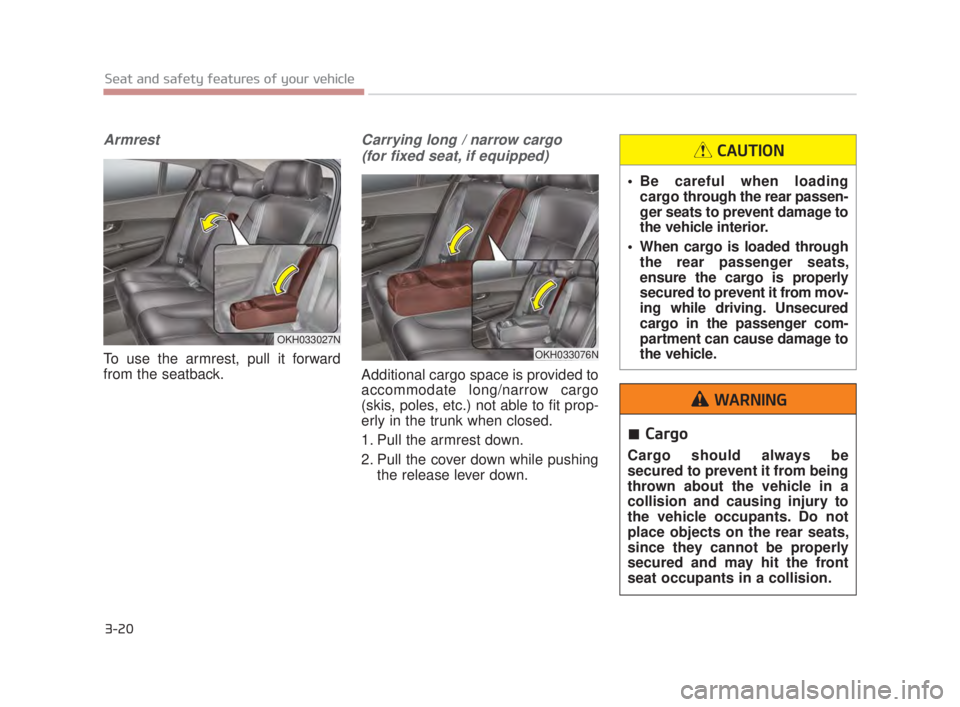
3-20
Seat and safety features of your vehicle
Armrest
To use the armrest, pull it forward
from the seatback.
Carrying long / narrow cargo (for fixed seat, if equipped)
Additional cargo space is provided to
accommodate long/narrow cargo
(skis, poles, etc.) not able to fit prop-
erly in the trunk when closed.
1. Pull the armrest down.
2. Pull the cover down while pushing the release lever down.
OKH033076N
OKH033027N
Be careful when loadingcargo through the rear passen-
ger seats to prevent damage to
the vehicle interior.
When cargo is loaded through the rear passenger seats,
ensure the cargo is properly
secured to prevent it from mov-
ing while driving. Unsecured
cargo in the passenger com-
partment can cause damage to
the vehicle.
CAUTION
Cargo
Cargo should always be
secured to prevent it from being
thrown about the vehicle in a
collision and causing injury to
the vehicle occupants. Do not
place objects on the rear seats,
since they cannot be properly
secured and may hit the front
seat occupants in a collision.
WARNING
KH USA 3:2018 4/18/2017 9:34 AM Page 20
Page 39 of 544
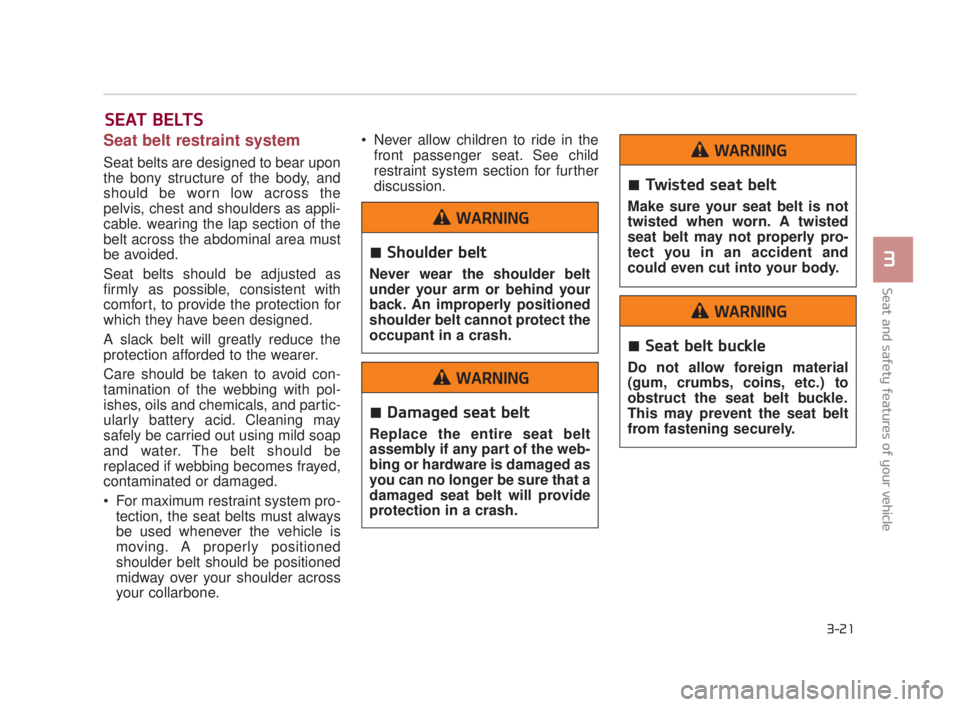
Seat and safety features of your vehicle
3
3-21
Seat belt restraint system
Seat belts are designed to bear upon
the bony structure of the body, and
should be worn low across the
pelvis, chest and shoulders as appli-
cable. wearing the lap section of the
belt across the abdominal area must
be avoided.
Seat belts should be adjusted as
firmly as possible, consistent with
comfort, to provide the protection for
which they have been designed.
A slack belt will greatly reduce the
protection afforded to the wearer.
Care should be taken to avoid con-
tamination of the webbing with pol-
ishes, oils and chemicals, and partic-
ularly battery acid. Cleaning may
safely be carried out using mild soap
and water. The belt should be
replaced if webbing becomes frayed,
contaminated or damaged.
For maximum restraint system pro-tection, the seat belts must always
be used whenever the vehicle is
moving. A properly positioned
shoulder belt should be positioned
midway over your shoulder across
your collarbone. Never allow children to ride in the
front passenger seat. See child
restraint system section for further
discussion.
SEAT BELTS
Shoulder belt
Never wear the shoulder belt
under your arm or behind your
back. An improperly positioned
shoulder belt cannot protect the
occupant in a crash.
WARNING
Damaged seat belt
Replace the entire seat belt
assembly if any part of the web-
bing or hardware is damaged as
you can no longer be sure that a
damaged seat belt will provide
protection in a crash.
WARNING
Twisted seat belt
Make sure your seat belt is not
twisted when worn. A twisted
seat belt may not properly pro-
tect you in an accident and
could even cut into your body.
WARNING
Seat belt buckle
Do not allow foreign material
(gum, crumbs, coins, etc.) to
obstruct the seat belt buckle.
This may prevent the seat belt
from fastening securely.
WARNING
KH USA 3:2018 4/18/2017 9:34 AM Page 21
Page 43 of 544
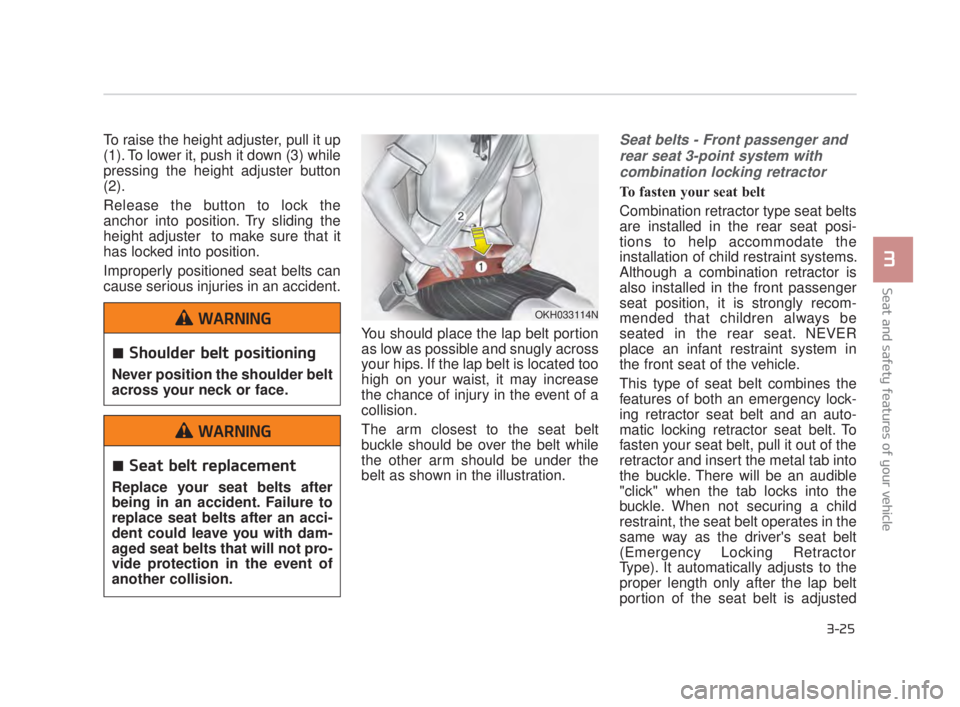
Seat and safety features of your vehicle
3
3-25
To raise the height adjuster, pull it up
(1). To lower it, push it down (3) while
pressing the height adjuster button
(2).
Release the button to lock the
anchor into position. Try sliding the
height adjuster to make sure that it
has locked into position.
Improperly positioned seat belts can
cause serious injuries in an accident.You should place the lap belt portion
as low as possible and snugly across
your hips. If the lap belt is located too
high on your waist, it may increase
the chance of injury in the event of a
collision.
The arm closest to the seat belt
buckle should be over the belt while
the other arm should be under the
belt as shown in the illustration.Seat belts - Front passenger andrear seat 3-point system withcombination locking retractor
To fasten your seat belt
Combination retractor type seat belts
are installed in the rear seat posi-
tions to help accommodate the
installation of child restraint systems.
Although a combination retractor is
also installed in the front passenger
seat position, it is strongly recom-
mended that children always be
seated in the rear seat. NEVER
place an infant restraint system in
the front seat of the vehicle.
This type of seat belt combines the
features of both an emergency lock-
ing retractor seat belt and an auto-
matic locking retractor seat belt. To
fasten your seat belt, pull it out of the
retractor and insert the metal tab into
the buckle. There will be an audible
"click" when the tab locks into the
buckle. When not securing a child
restraint, the seat belt operates in the
same way as the driver's seat belt
(Emergency Locking Retractor
Type). It automatically adjusts to the
proper length only after the lap belt
portion of the seat belt is adjusted
OKH033114N
Shoulder belt positioning
Never position the shoulder belt
across your neck or face.
WARNING
Seat belt replacement
Replace your seat belts after
being in an accident. Failure to
replace seat belts after an acci-
dent could leave you with dam-
aged seat belts that will not pro-
vide protection in the event of
another collision.
WARNING
KH USA 3:2018 4/18/2017 9:35 AM Page 25
Page 49 of 544
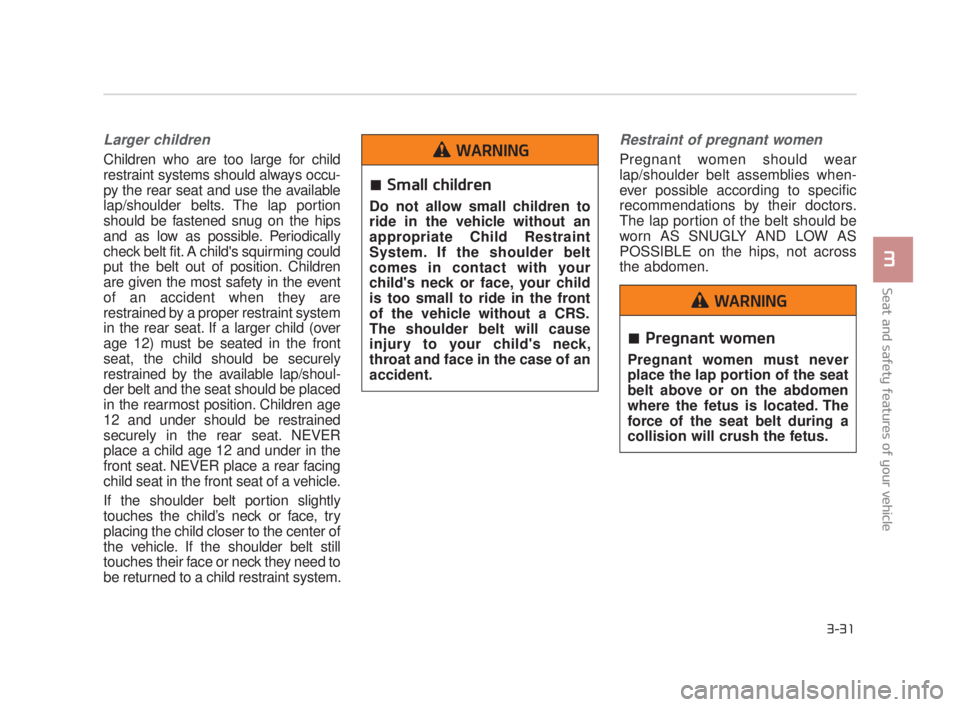
Seat and safety features of your vehicle
3
3-31
Larger children
Children who are too large for child
restraint systems should always occu-
py the rear seat and use the available
lap/shoulder belts. The lap portion
should be fastened snug on the hips
and as low as possible. Periodically
check belt fit. A child's squirming could
put the belt out of position. Children
are given the most safety in the event
of an accident when they are
restrained by a proper restraint system
in the rear seat. If a larger child (over
age 12) must be seated in the front
seat, the child should be securely
restrained by the available lap/shoul-
der belt and the seat should be placed
in the rearmost position. Children age
12 and under should be restrained
securely in the rear seat. NEVER
place a child age 12 and under in the
front seat. NEVER place a rear facing
child seat in the front seat of a vehicle.
If the shoulder belt portion slightly
touches the child’s neck or face, try
placing the child closer to the center of
the vehicle. If the shoulder belt still
touches their face or neck they need to
be returned to a child restraint system.
Restraint of pregnant women
Pregnant women should wear
lap/shoulder belt assemblies when-
ever possible according to specific
recommendations by their doctors.
The lap portion of the belt should be
worn AS SNUGLY AND LOW AS
POSSIBLE on the hips, not across
the abdomen.
Small children
Do not allow small children to
ride in the vehicle without an
appropriate Child Restraint
System. If the shoulder belt
comes in contact with your
child's neck or face, your child
is too small to ride in the front
of the vehicle without a CRS.
The shoulder belt will cause
injury to your child's neck,
throat and face in the case of an
accident.
WARNING
Pregnant women
Pregnant women must never
place the lap portion of the seat
belt above or on the abdomen
where the fetus is located. The
force of the seat belt during a
collision will crush the fetus.
WARNING
KH USA 3:2018 4/18/2017 9:35 AM Page 31
Page 51 of 544
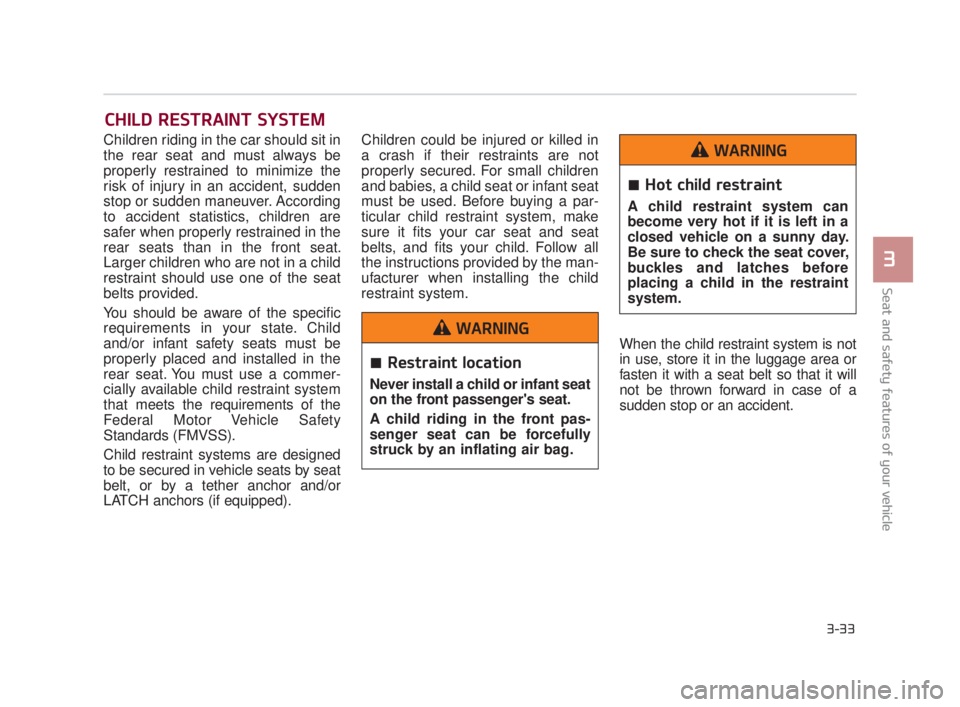
Seat and safety features of your vehicle
3
3-33
CHILD RESTRAINT SYSTEM
Children riding in the car should sit in
the rear seat and must always be
properly restrained to minimize the
risk of injury in an accident, sudden
stop or sudden maneuver. According
to accident statistics, children are
safer when properly restrained in the
rear seats than in the front seat.
Larger children who are not in a child
restraint should use one of the seat
belts provided.
You should be aware of the specific
requirements in your state. Child
and/or infant safety seats must be
properly placed and installed in the
rear seat. You must use a commer-
cially available child restraint system
that meets the requirements of the
Federal Motor Vehicle Safety
Standards (FMVSS).
Child restraint systems are designed
to be secured in vehicle seats by seat
belt, or by a tether anchor and/or
LATCH anchors (if equipped).Children could be injured or killed in
a crash if their restraints are not
properly secured. For small children
and babies, a child seat or infant seat
must be used. Before buying a par-
ticular child restraint system, make
sure it fits your car seat and seat
belts, and fits your child. Follow all
the instructions provided by the man-
ufacturer when installing the child
restraint system.
When the child restraint system is not
in use, store it in the luggage area or
fasten it with a seat belt so that it will
not be thrown forward in case of a
sudden stop or an accident.
Restraint location
Never install a child or infant seat
on the front passenger's seat.
A child riding in the front pas-
senger seat can be forcefully
struck by an inflating air bag.
WARNING
Hot child restraint
A child restraint system can
become very hot if it is left in a
closed vehicle on a sunny day.
Be sure to check the seat cover,
buckles and latches before
placing a child in the restraint
system.
WARNING
KH USA 3:2018 4/18/2017 9:35 AM Page 33